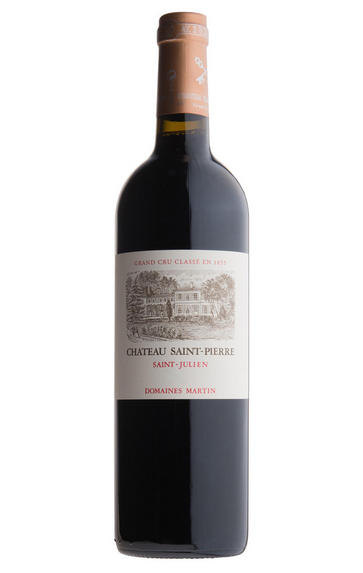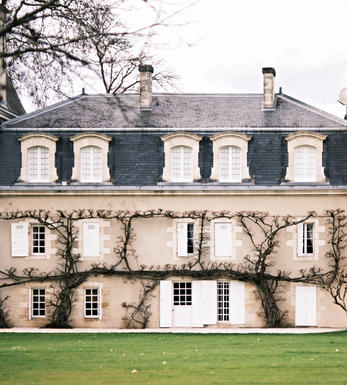
2010 Château Saint-Pierre, St Julien, Bordeaux

Critics reviews
Robert M. Parker, Jr. - 28/02/2013
Tasted blind 8 Apr: Only mid intensity of crimson. Savoury tobacco-leaf aromas. Great solid whack of fruit intensity on the front palate makes its presence felt in this, the first St-Julien I taste immediately after a run of Haut-Médocs. Very solid indeed. This will need quite a time to resolve itself into a gentle drink as opposed to a half-formed monument. Bone dry.
Jancis Robinson MW- jancis robinson.com, Apr 2011
James Molesworth – The Wine Spectator – Mar 2011
Robert Parker- Wine Advocate- Feb 2013
A killer trilogy (2008, 2009 and 2010) has been produced by Saint-Pierre and the 2010 is unquestionably one of the all-time great wines this estate has yet made. A candidate for one of the top wines of this remarkable vintage, it offers a thunderball of fruit, extract, glycerin and intensity. Its black/purple color is accompanied by notes of melted licorice, camphor, blackberries, blueberries, creme de cassis and subtle background oak, amazing concentration, unbelievable opulence and intense, but sweet, well-integrated tannins. Moreover, because of lower pH’s and higher total acids across the board in 2010, and despite the high alcohols (this wine’s alcohol content must be 14.5+%), the overall impression is one of elegance, freshness and precision. This cuvee reminded me somewhat of a St.-Julien version of another of the superstars of the vintage, the 2010 Pichon Longueville Baron. The 2010 Saint-Pierre should drink well for 30-40 years.
Robert Parker- Wine Advocate- May 2011
About this WINE

Château Saint-Pierre
Château Saint-Pierre is the smallest Classified Growth in St Julien. It was ranked a Fourth Growth in 1855, but over the next century it was broken up into smaller and smaller parts. It was restored to its original holdings in 1982 by then-owner Henri Martin, proprietor of nearby Château Gloria. Today, his legacy lives on through his son-in-law Jean-Louis Triaud, and Jean-Louis’s own children.
The elegant château building looks rather classic, but it belies a surprisingly modern approach behind the scenes. Infrared photography of the vineyard allows the team to carefully plan out harvesting schedules to the level of the individual plant. This 17-hectare estate is undergoing organic conversion and holds HVE-3 certification. Viticulture follows a bespoke mix of techniques picked up from organics and biodynamics, which Jean-Louis calls “our own system”.
There have been advances in the winery, too. Instead of pumping-over once in the morning and once in the afternoon, there are small pump-overs at hourly intervals, working around the clock. Amphorae are already a fixture of the cellar, and Jean-Louis hopes to reach a 50-50 balance between amphorae and the more traditional new French oak barriques.

St Julien
St Julien is the smallest of the "Big Four" Médoc communes. Although, without any First Growths, St Julien is recognised to be the most consistent of the main communes, with several châteaux turning out impressive wines year after year.
St Julien itself is much more of a village than Pauillac and almost all of the notable properties lie to its south. Its most northerly château is Ch. Léoville Las Cases (whose vineyards actually adjoin those of Latour in Pauillac) but, further south, suitable vineyard land gives way to arable farming and livestock until the Margaux appellation is reached.
The soil is gravelly and finer than that of Pauillac, and without the iron content which gives Pauillac its stature. The homogeneous soils in the vineyards (which extend over a relatively small area of just over 700 hectares) give the commune a unified character.
The wines can be assessed as much by texture as flavour, and there is a sleek, wholesome character to the best. Elegance, harmony and perfect balance and weight, with hints of cassis and cedar, are what epitomise classic St Julien wines. At their very best they combine Margaux’s elegance and refinement with Pauillac’s power and substance.
Ch. Léoville Las Cases produces arguably the most sought-after St Julien, and in any reassessment of the 1855 Classification it would almost certainly warrant being elevated to First Growth status.
Recommended Châteaux: Ch. Léoville Las Cases, Ch.Léoville Barton, Ch Léoville Poyferré, Ch. Ducru-Beaucaillou, Ch Langoa Barton, Ch Gruaud Larose, Ch. Branaire-Ducru, Ch. Beychevelle

Cabernet Sauvignon Blend
Cabernet Sauvignon lends itself particularly well in blends with Merlot. This is actually the archetypal Bordeaux blend, though in different proportions in the sub-regions and sometimes topped up with Cabernet Franc, Malbec, and Petit Verdot.
In the Médoc and Graves the percentage of Cabernet Sauvignon in the blend can range from 95% (Mouton-Rothschild) to as low as 40%. It is particularly suited to the dry, warm, free- draining, gravel-rich soils and is responsible for the redolent cassis characteristics as well as the depth of colour, tannic structure and pronounced acidity of Médoc wines. However 100% Cabernet Sauvignon wines can be slightly hollow-tasting in the middle palate and Merlot with its generous, fleshy fruit flavours acts as a perfect foil by filling in this cavity.
In St-Emilion and Pomerol, the blends are Merlot dominated as Cabernet Sauvignon can struggle to ripen there - when it is included, it adds structure and body to the wine. Sassicaia is the most famous Bordeaux blend in Italy and has spawned many imitations, whereby the blend is now firmly established in the New World and particularly in California and Australia.


Buying options
Add to wishlist
Description
Only 8000 cases a year are produced from this St Julien wine property and, for me, it is one of the best estates in this commune, just below the likes of Las Cases and Ducru Beaucaillou. From 2004 onwards this estate has outperformed most of its peers, and the last three vintages have been mesmerising.
The 2010 shows some intense cassis and plums on the nose and huge amounts of freshly-crushed black fruit on the palate. It has a remarkable balance between fruit and acidity, and the tannins stretch all the way across the palate and into the finish. This is one of the wines of the week.
Max Lalondrelle, Bordeaux Wine Buyer
wine at a glance
Delivery and quality guarantee